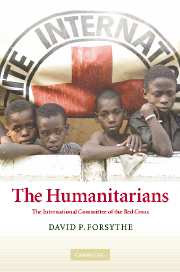Book contents
- Frontmatter
- Contents
- Preface
- List of abbreviations
- Introduction
- PART ONE Historical analysis
- PART TWO Policy analysis
- PART THREE Conclusion
- Annexe A The ICRC and the Red Cross movement
- Annexe B The ICRC and selected private relief agencies
- Annexe C The ICRC: one of the Big Four relief agencies
- Annexe D The ICRC and selected advocacy groups
- Annexe E The ICRC organizational chart
- Bibliography
- Index
- References
Bibliography
Published online by Cambridge University Press: 06 July 2010
- Frontmatter
- Contents
- Preface
- List of abbreviations
- Introduction
- PART ONE Historical analysis
- PART TWO Policy analysis
- PART THREE Conclusion
- Annexe A The ICRC and the Red Cross movement
- Annexe B The ICRC and selected private relief agencies
- Annexe C The ICRC: one of the Big Four relief agencies
- Annexe D The ICRC and selected advocacy groups
- Annexe E The ICRC organizational chart
- Bibliography
- Index
- References
- Type
- Chapter
- Information
- The HumanitariansThe International Committee of the Red Cross, pp. 321 - 338Publisher: Cambridge University PressPrint publication year: 2005



